
|
Sale 98
The Pre-Long Beach Auction June 4-7, 2017
| Lot |
Photo |
Description |
Realized |
Lot 2077 |
 |
Iberia, Punic issues. Silver Shekel (6.74 g), ca. 237-209 BC. Diademed male head (Hasdrubal?) left. Reverse: Prow of galley right, with shield on deck and wreathed forepost terminating in a bird's head to which is attached a pennant; in exergue, dolphin right. Robinson pp. 37-38, pl. II, 4c; ACIP 543; SNG BM 91. Rare. Excellent detail, struck on a porous planchet. Very Fine. Estimate Value $1,500 - 2,000
While the prow reverse of this coin obviously refers to Carthaginian sea power, the diademed head on the obverse is less certain. Although it could represent a Carthaginian deity, it gives the strong impression of a portrait. This has led to the suggestion that it represents none other than Hasdrubal, son of the famous Hamilcar Barca, and brother of the legendary Hannibal. Hasdrubal was left to command the Punic forces in Iberia when Hannibal departed for his invasion of Italy in 218 BC. He followed with reinforcements in 209 BC, but was defeated and killed by Roman forces at the battle of the Metaurus. The head of the hapless Hasdrubal was thrown into the camp of Hannibal as a warning of the defeat that the Romans intended to inflict on the Carthaginians.
View details and enlarged photos
| Realized
$1,140 |
Lot 2078 |
 |
Iberia, Punic issues. Silver 1/4 Shekel (1.62 g), ca. 237-209 BC. Male head left. Reverse: Horse standing right. ACIP 605; SNG BM 117. Scarce. Porous planchet. Very Fine. Estimate Value $400 - 500
View details and enlarged photos
| Realized
$960 |
Lot 2079 |
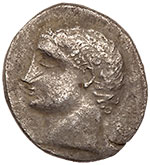 |
Iberia, Punic issues. Silver 1/2 Shekel (3.53 g), ca. 237-209 BC. Male head left. Reverse: Horse standing right. ACIP 607; SNG BM 114-6. Rare denomination. Porous planchet. About Very Fine. Estimate Value $400 - 500
View details and enlarged photos
| Realized
$1,020 |
Lot 2080 |
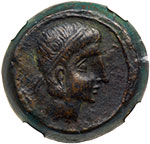 |
Iberia, Castulo. Æ As (27.18 g), mid-2nd century BC. Diademed male head right. Reverse: Sphinx right, left forepaw raised; in right field, star. ACIP 2126; SNG BM 1298. Brown patina. NGC grade Ch VF; Strike: 4/5, Surface: 3/5. Light smoothing. Estimate Value $250 - 300
View details and enlarged photos
| Unsold |
Lot 2081 |
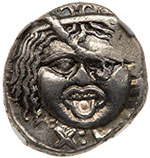 |
Etruria, Populonia. Silver 20 Asses (8.64 g), 3rd century BC. Diademed facing head of Metusa; below, X:X. Reverse: Blank. EC grp. XII, series 52 (O20); HN Italy 142. Late die state. NGC grade Ch XF; Strike: 4/5, Surface: 4/5. Estimate Value $800 - 900
View details and enlarged photos
| Unsold |
Lot 2082 |
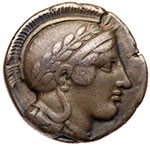 |
Lucania, Thourion. Silver Nomos (6.67 g), ca. 443-400 BC. Head of Athena right, wearing Attic helmet decorated with laurel wreath. Reverse: ΘOYPIΩ[N], bull walking left, head lowered; below, Δ; in exergue, fish left. SNG ANS 885-9; HN Italy 1760. Uniform old cabinet toning. Very Fine. Estimate Value $300 - 400
View details and enlarged photos
| Realized
$200 |
Lot 2083 |
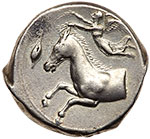 |
Sicily, Entella. Silver Tetradrachm (17.62 g), ca. 407-398 BC. Siculo-Punic issue. Forepart of horse left; above, Nike flying left, crowning horse with wreath; in left field, barley corn. Reverse: 'QRTHDST' below, palm tree with two date clusters. Jenkins 30 (O8/R29); SNG Lloyd 1607 (same dies). Untoned. Well struck and nicely centered. Extremely Fine. Estimate Value $5,000 - UP
From the Dr. Patrick Tan Collection. Ex CNR XLI.3 (Fall 2016); Marian A. Sinton Collection (Triton III, 30 November 1999), 337; Noble 64A (12 July 2000), 2425.
This tetradrachm was struck by the Punic forces based in the Sicilian city of Entella during the offensive against the Greek cities of eastern Sicily in 407-398 BC. Despite the frequent outbreak of plague during the campaign, by its end, Carthage was at the height of its power in Sicily, with the cities of Selinos, Thermai, Akragas, Gela and Kamarina all under Punic domination. The horse forepart crowned by Nike on the obverse had a dual meaning. On the one hand it referred to the Campanian mercenaries who were an important component of Punic armies on Sicily and whose home cities often used a galloping horse as a type. On the other hand it could be read as an allusion to Carthage, a city said to have been founded on a hill where the head of a horse was uncovered. The palm tree reverse makes reference to the Phoenician origin of the Punic Carthaginians: the Greek name for the region is derived from phoinix, the Greek word for "palm tree."
View details and enlarged photos
| Realized
$6,756 |
Lot 2084 |
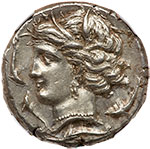 |
Sicily, Entella. Silver Tetradrachm (17.35 g), ca. 320/15-300 BC. Siculo-Punic issue. Head of Arethusa left, wreathed with grain ears, wearing triple-pendant earring and necklace; four dolphins around. Reverse: Horse's head right; behind, palm tree. Jenkins 268 (O82/R222); de Luynes 1470 (same obv. die). Boldly struck and well centered. Lustrous surfaces and delicately toned. NGC grade Ch AU*; Strike: 5/5, Surface: 5/5. Estimate Value $5,000 - 6,000
From the Dr. Patrick Tan Collection.
Probably struck during or in preparation for the great conflict between Punic Carthage and Syracuse under the tyrant Agathokles that raged from 315-307 BC, this tetradrachm illustrates the immense impact of Greek culture on the development of Siculo-Punic coinage. The obverse depiction of the Semitic deity Tanit is lifted directly from Syracusan tetradrachms featuring Persephone-Arethusa - even down to the encircling dolphins. The horse's head reverse may allude to the foundation myth of Carthage, in which the city was founded by Dido of Tyre on a hill where the head of a horse was uncovered. This was an omen of the city's future prowess in war. The small palm tree in the background is a Greek pun on the Phoenician origin of Punic Carthage: the geographical name Phoenicia is derived from phoinix, the Greek word for palm tree.
View details and enlarged photos
| Realized
$6,756 |
Lot 2085 |
 |
Sicily, Gela. Silver Tetradrachm (17.26 g), ca. 480/75-475/0 BC. Charioteer driving slow quadriga right; above, Nike flying right, crowning horses with wreath. Reverse: CEΛAΣ, forepart of man-headed bull to right. Jenkins grp. II, 104 (O32/R59); Randazzo 19 (same dies); SNG ANS 22 (same dies); SNG Ashmolean 1727 (same dies); SNG Copenhagen 251 (same dies); Jameson 580 (same dies). Boldly struck and unusually well centered. Lustrous and delicately toned. NGC grade Ch AU; Strike: 4/5, Surface: 4/5. Fine style, overstruck. Estimate Value $4,000 - 5,000
From the Dr. Patrick Tan Collection. Ex Goldberg 91 (7 June 2016), 1717.
Found by colonists from Rhodes and Crete in 688 BC, Gela was located on the south-eastern coastal plain of Sicily along the banks of the river Gela, from which it reaped a fertile soil and bountiful harvests. By the early fifth century, the wealth generated from its hinterland allowed the city's early tyrants to expand militarily at the expense of its neighbors, and Gela soon dominated several cities, amongst them Leontinoi, Naxos, Zankle-Messana and Syracuse. The tyrant Gelon, after conquering Syracuse, moved there, leaving his brother Hieron I in charge of Gela. After Gelon's death in 478 BC, Hieron took control of Syracuse and left the city of Gela to Polyzelos. Little is known of Polyzelos, but it was during his tyranny that the city began striking tetradrachms, replacing the earlier didrachms that had been the principal denomination in use at Gela. The charioteer on the obverse is copied from Syracuse, but shows the Charioteer of Delphi, one of the most well-known bronze statues from antiquity and which Polyzelos dedicated to Apollo of Delphi in order to celebrate the victory of his chariot in the Pythian Games of either 478 or 474. The reverse reuses the type from the city's didrachm coinage, and depicts the forepart of the river-god Gelas. The immediate impression when first looking at this particular coin is that the detail is exceptional, and that the dies were engraved by a truly skilled artist. Indeed, the dies used to strike this coin are the first of the series, so it stands to reason that the artist was perhaps contracted by Polyzalos himself, who sought out the finest masters in order to commemorate both his rule over his city and his Pythian victory with a new denomination.
View details and enlarged photos
| Realized
$4,994 |
Lot 2086 |
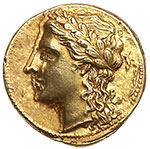 |
Sicily, Syracuse. Agathokles, 317-289 BC. Electrum 50 Litrai (3.54 g). Ca. 310-306/5 BC. Laureate head of Apollo left; behind, wing. Reverse: ΣYPAK-OΣIΩN, tripod-lebes; above, phiale. Jenkins grp. C, dies O23/R40; SNG Fitzwilliam 1289 (same obv. die); Guzman Collection (Sotheby's, 20 July 1914), 104 (same dies); HGC 2, 1294. Boldly struck in deep yellow electrum, slightly doubled on the obverse. Extremely Fine. Estimate Value $2,000 - 2,500
View details and enlarged photos
| Realized
$2,468 |
Lot 2087 |
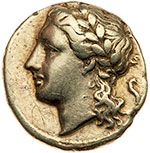 |
Sicily, Syracuse. 317-319 B.C. Struck under Agathakles. EL 50 Litrai (3.56 g). Laureate head of Apollo left; dolphin to right. Reverse: ΣYPAKOΣIΩN. Tripod- lebes. Sear 957; Hoover 1294; Jenkins, Electrum, Group C. struck in pale color electrum. Some faint scratches on the obverse. Fine to Very Fine. Estimate Value $500 - 600
View details and enlarged photos
| Realized
$960 |
Lot 2088 |
|
Withdrawn
| Unsold |
Lot 2089 |
 |
Sicily, Syracuse. Hieron II. Æ (16.90 g), 275-215 BC. Ca. 230-218/5 BC. Diademed head of Hieron II left. Reverse: [I]EPΩNOΣ, horseman riding right, holding spear; below, Σω. CNS 195; BAR issue 62; SNG ANS -. Glossy dark brown patina. Choice Very Fine. Estimate Value $300 - 400
From The Herbert & Aphrodite Rubin Collection; Purchased privately from Seaby Coins in the 1980s.
View details and enlarged photos
| Realized
$470 |
Lot 2090 |
 |
Macedonia, under Roman rule. First Meris. Silver Tetradrachm (16.85 g), ca. 167-148 BC. Amphipolis. Macedonian shield with central boss depicting diademed and draped bust of Artemis right, bow and quiver at shoulder. Reverse: MAKEΔONΩN ΠPΩTHΣ, club; above, monogram; below, two monograms; all within oak-wreath; to left, thunderbolt. AMNG III 178; SNG Ashmolean 3299. Beautifully toned. Superb Extremely Fine. Estimate Value $700 - 800
View details and enlarged photos
| Unsold |
Lot 2091 |
 |
Macedonia, Eion. Silver Trihemiobol (0.83 g), ca. 460-400 BC. Goose standing right, head left; above, lizard left; in lower right field, H. Reverse: Quadripartite incuse square. Cf. SNG ANS 291 (position of H); HGC 3.1, 521. Lightly toned, flan crack at 4 o'clock. Choice Very Fine. Estimate Value $300 - 400
Purchased from NFA in the 1980s (with ticket).
View details and enlarged photos
| Unsold |
Lot 2092 |
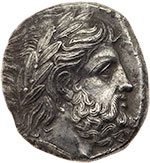 |
Macedonian Kingdom. Philip II. Silver Tetradrachm (14.36 g), 359-336 BC. Pella, lifetime issue, ca. 354/3-ca. 349/8 BC. Laureate head of Zeus right. Reverse: ΦIΛIΠ-ΠOY, king on horseback left, wearing kausia and extending arm in salute; below horse's raised foreleg, facing head of Helios. Le Rider 105 (D60/R84); SNG ANS 357. An absolutely incredible lifetime issue of Philip II. One of the most powerful portraits of Zeus on a coin! Worthy of the finest collection. Toned. NGC grade Ch AU; Strike: 5/5, Surface: 5/5. Fine style. Estimate Value $7,000 - UP
From the Dr. Patrick Tan Collection. Purchased privately from H. Berk.
The tetradrachms of Philip II were struck in large quantities thanks to his control of the important mines of Mount Pangaion after 354 BC. The coins enjoyed a wide popularity even beyond the borders of the Macedonian kingdom and provided the model for the imitative coinages of the Danubian Celts. The obverse features the head of Olympian Zeus, the chief god of the Macedonians while the reverse depicts a Macedonian rider wearing a kausia - the national Macedonian hat similar to the petasos. His bearded face and what may be the trailing end of a diadem behind his head indicate that he is none other than the king himself.
View details and enlarged photos
| Realized
$14,100 |
Lot 2093 |
 |
Macedonian Kingdom. Philip II. Silver Tetradrachm (14.48 g), 359-336 BC. Pella, ca. 342/1-ca. 337/6 BC. Laureate head of Zeus right. Reverse: ΦIΛIΠ-[Π]OY, youth on horseback right, crowning horse with palm; below horse's belly, horizontal thunderbolt. Le Rider 196 (D114/R160); cf. SNG ANS 379 (thunderbolt vertical). Perfectly struck in high relief and nicely toned. Quite artistic. NGC grade AU; Strike: 5/5, Surface: 3/5. Fine style. Estimate Value $2,500 - 3,000
From the Dr. Patrick Tan Collection.
View details and enlarged photos
| Realized
$5,288 |
Lot 2094 |
 |
Macedonian Kingdom. Philip II. Silver Tetradrachm (13.66 g), 359-336 BC. Amphipolis, under Philip III or Alexander IV, ca. 323-315 BC. Laureate head of Zeus right. Reverse: ΦIΛIΠ-ΠOY, youth on horseback right, holding palm; beneath horse's belly, grain ear; below raised foreleg, Π. Le Rider pl. 46, 3; SNG ANS 668. Light antique grey toning. Well centered with even wear and ancient test cut on horse's chest. Very Fine. Estimate Value $400 - 500
View details and enlarged photos
| Realized
$235 |
Lot 2095 |
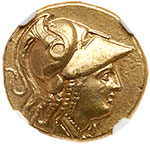 |
Macedonian Kingdom. Alexander III 'the Great'. Gold Stater (8.62 g), 336-323 BC. Salamis, or uncertain mint in western Asia Minor, lifetime issue, ca. 330/25-323 BC. Head of Athena right, wearing crested Attic helmet decorated with coiled serpent. Reverse: AΛEΞANΔPO[Y], Nike standing facing, head left, holding wreath and stylis; in left field, head of satyr left; in right field, monogram in wreath. Price 3137; Troxell grp. I. NGC grade Ch AU; Strike: 5/5, Surface: 4/5. Estimate Value $2,500 - 3,000
From the Dr. Patrick Tan Collection.
View details and enlarged photos
| Realized
$4,113 |
Lot 2096 |
 |
Macedonian Kingdom. Alexander III 'the Great'. Gold Stater (8.56 g), 336-323 BC. Tyre, RY 23 of Azemilkos (327/6 BC), lifetime issue. Head of Athena right, wearing crested Attic helmet decorated with coiled serpent. Reverse: AΛEΞANΔP[OY], Nike standing facing, head left, holding wreath and stylis; in left field below wing, tiny alef; in right field below wing, date. Price 3257 (same obv. die as illus.); Newell 27 corr. NGC grade Ch XF; Strike: 5/5, Surface: 5/5. Estimate Value $2,000 - 2,500
From the Dr. Patrick Tan Collection.
View details and enlarged photos
| Realized
$2,468 |
Lot 2097 |
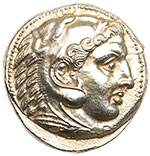 |
Macedonian Kingdom. Alexander III 'the Great'. Silver Tetradrachm (17.24 g), 336-323 BC. Pella, ca. 323-318/7 BC. Head of Herakles right, wearing lion's skin headdress. Reverse: BAΣI-ΛEΩΣ AΛEΞANΔPOY, Zeus seated left, holding eagle and scepter; in left field, bee alighting on rose. Price 206; Moore 23-43. Boldly struck in high relief. Needle sharp and superb. Untoned. Nearly Mint State. Estimate Value $1,500 - 2,000
View details and enlarged photos
| Unsold |
Lot 2098 |
 |
Macedonian Kingdom. Alexander III 'the Great'. Silver Tetradrachm (17.19 g), 336-323 BC. Susa, under Antigonos I Monopthalmos, 316-311 BC. Head of Herakles right, wearing lion's skin headdress. Reverse: BAΣIΛEΩΣ AΛEΞANΔPOY, Zeus seated left, holding eagle and scepter; in left field, wreath; below throne, above strut, AI; below strut, monogram. Price 3857. Untoned. Extremely Fine. Estimate Value $600 - 700
View details and enlarged photos
| Realized
$588 |
Lot 2099 |
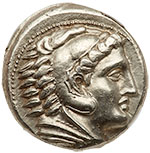 |
Macedonian Kingdom. Alexander III 'the Great'. Silver Tetradrachm (17.22 g), 336-323 BC. Amphipolis, ca. 322-320 BC. Head of Herakles right, wearing lion's skin headdress. Reverse: BAΣIΛEΩΣ AΛEΞANΔPOY, Zeus seated left, holding eagle and scepter; in left field, Macedonian helmet. Price 113; Troxell issue H3. Untoned and nice and crisp. NGC grade Choice AU; Strike: 5/5, Surface: 4/5. Estimate Value $800 - 900
View details and enlarged photos
| Realized
$734 |
Lot 2100 |
 |
Macedonian Kingdom. Philip III Arrhidaios. Silver Tetradrachm (17.03 g), 323-317 BC. Babylon, ca. 323-318/7 BC. Head of Herakles right, wearing lion's skin headdress. Reverse: BAΣIΛEΩΣ ΦIΛIΠΠOY, Zeus seated left, holding eagle and scepter; in left field, wheel and monogram; below throne, monogram. Price P189. Untoned. Extremely Fine. Estimate Value $500 - 600
View details and enlarged photos
| Unsold |
Lot 2101 |
 |
Macedonian Kingdom. Time of Philip V-Perseus. Silver Tetrobol (2.19 g), ca. 221-168 BC. Uncertain Macedonian mint. Wreathed head of maenad right. Reverse: MAKE-ΔONΩN, stern of galley right; in right field, Π. SNG Ashmolean 3287. Toned. Extremely Fine. Estimate Value $200 - 250
From The Herbert & Aphrodite Rubin Collection; Purchased privately from Bowers and Ruddy Galleries in the 1980s.
View details and enlarged photos
| Unsold |
Lot 2102 |
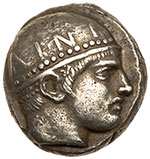 |
Thrace, Ainos. Silver Tetradrachm (16.28 g), ca. 453-451 BC. Antiadas, magistrate. AINI, laureate head of Hermes right, wearing petasos. Reverse: Goat walking right within linear frame; around, magistrate's name: ANTIAΔAΣ; to right, Pan standing right, holding lagobolon and extending arm; all within incuse square. May 85 (A55/P68); Jameson 1050. Very Rare. Well struck on a small flan. Old cabinet toning. Choice Very Fine. Estimate Value $4,000 - 5,000
Ex Edgar L. Owen.
The depiction of Hermes here in this wonderful severe classical style represents the patron deity of Ainos. According to Apollonius Rhodes, the celebrated author of the Argonautica, the cult of Hermes came to Ainos in a remarkable fashion. His wooden cult image was originally constructed by Epeios, the Greek craftsman responsible for the Trojan Horse, but it was washed out to sea. The image drifted in the Aegean until it came ashore near the Hebros River in Thrace, and was then found by Thracian fisherman who assumed it was mundane driftwood and attempted to use it to fuel their fire. When the wood of the cult image would not burn, the fishermen threw it back into the Aegean, but the sea immediately spat it out onto the shore. Suddenly realizing that they were dealing with no simple driftwood but rather an image imbued with divine power, the fishermen subsequently venerated the wooden image and erected a shrine for it. (Evidently no one bothered to reflect that waterlogged wood often has a tendency not to burn or that the action of waves often brings objects back to shore). The Greeks identified the god of the xoanon as Hermes and gave him the epithet Perpheraios, meaning, "the Wanderer" in recognition of the image's travels at sea before arriving in Thrace. The goat featured on the reverse was the animal sacred to Hermes while the image of Pan alludes to another local cult of Ainos. This rustic deity was worshipped together with the nymphs in a cave at the foot of the acropolis at Ainos.
View details and enlarged photos
| Realized
$3,819 |
Lot 2103 |
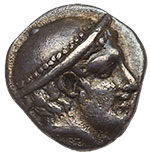 |
Thrace, Ainos. Silver Diobol (1.28 g), ca. 408/7-407/6 BC. Head of Hermes right, wearing petasos. Reverse: AINI, goat standing right, pawing at ground; below raised foreleg, crab; all within incuse square. May 292-309; AMNG II 295. Fine style. Pleasing old cabinet tone. Very Fine. Estimate Value $400 - 500
View details and enlarged photos
| Unsold |
Lot 2104 |
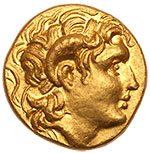 |
Thracian Kingdom. Lysimachos. Gold Stater (8.54 g), as King, 306-281 BC. Uncertain mint, early posthumous issue, ca. 280-250 BC. Diademed head of deified Alexander right, with horn of Ammon. Reverse: BAΣIΛEΩ[Σ] ΛYΣIMAΧOY, Athena seated left, holding Nike and resting elbow on shield at side, spear leaning against far shoulder; in inner left field, AΘ monogram. Müller 478. Well struck in high relief and perfectly centered. Lovely style and lustrous. Superb Extremely Fine. Estimate Value $6,000 - 7,000
View details and enlarged photos
| Realized
$7,344 |
Lot 2105 |
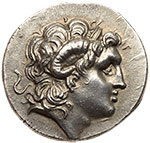 |
Thracian Kingdom. Lysimachos. Silver Tetradrachm (16.88 g), as King, 306-281 BC. Uncertain mint, 3rd century BC. Diademed head of deified Alexander right, with horn of Ammon. Reverse: BAΣIΛEΩΣ ΛYΣIMAΧOY, Athena seated left, holding Nike and resting elbow on shield at side, spear leaning against her far shoulder; in inner left field, bearded head left; in exergue, AP monogram. Müller 452; Tkalec, April 2011, 42 (same dies). Extremely Rare - perhaps the fourth known specimen . Lightly toned and excellent metal. Superb Extremely Fine. Estimate Value $2,500 - UP
From the Dr. Patrick Tan Collection.
View details and enlarged photos
| Realized
$3,995 |
Lot 2106 |
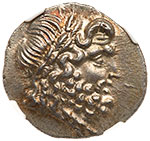 |
Thessaly, Thessalian League. Silver Stater (6.19 g), mid-late 1st century BC. Alexandros and Menekrates, magistrates. Head of Zeus right, wearing oak wreath. Reverse: ΘEΣΣA-ΛΩN, Athena Itonia advancing right right, wielding spear and holding forth shield on outstretched arm; above and in exergue, magistrate's names: AΛEΞ-ANΔP[OY] and MENEKPATHΣ. BCD Thessaly II 844; BMC 5. A beautiful gem specimen and lightly toned. NGC grade MS; Strike: 5/5, Surface: 5/5. Estimate Value $700 - 800
View details and enlarged photos
| Unsold |
Lot 2107 |
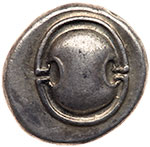 |
Boiotia, Federal coinage. Silver Hemidrachm (2.75 g), ca. 395-340 BC. Boiotian shield. Reverse: B-OI, kantharos; in right field, ivy-leaf, all within shallow incuse square. BCD Boiotia 30; SNG Copenhagen 173. Lovely strike on a nice broad flan. Lightly toned. Extremely Fine. Estimate Value $300 - 350
View details and enlarged photos
| Unsold |
Lot 2108 |
 |
Attica, Athens. Silver Tetradrachm (17.20 g), ca. 454-404 BC. Helmeted head of Athena right, frontal eye. Reverse: AΘE, owl standing right, head facing; above to left, olive-spray with berry and crescent; all within incuse square. Kroll 8; Svoronos pl. 14; SNG Copenhagen 31-40. Boldly struck and perfectly centered. A superb example. All lightly toned. NGC grade Ch AU*; Strike: 5/5, Surface: 5/5. Estimate Value $2,500 - 3,000
From the Dr. Patrick Tan Collection.
The beauty afforded to this iconic coin of Classical Greece by the sharpness of the strike and its superlative state of preservation make it a real gem among the vast number of Athenian "owl" tetradrachms struck in the fifth century BC. The Athenian "owls" were produced from silver from the Laurion mines of Attica and used to fund such major enterprises as the Periklean building program, which served to beautify Athens as the capital of a naval empire and, the Peloponnesian War (431-404 BC) that broke out because of the fear of that empire. The "owls" were widely accepted in international trade and their types became a symbol of good money. Therefore the types remained unaltered until the introduction of the Athenian New Style coinage in c. 165 BC.
View details and enlarged photos
| Realized
$2,056 |
Lot 2109 |
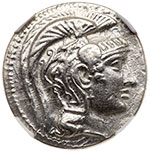 |
Attica, Athens. Silver Tetradrachm (17.00 g), ca. 165-42 BC. 133/2 BC. Polych(armos), Nicog., and Themistokles, magistrates. Head of Athena right, wearing triple crested Attic helmet decorated with Pegasos springing right. Reverse: A-ΘE, owl standing right, head facing, on overturned amphora; across field, magistrates' names: ΠOΛY-ΧAPM, NIKOΓ, and ΘEMIΣ/TOKΛH; to left, winged caduceus; Z on amphora, ΔI below; all within laurel wreath. Thompson 379d. Well struck and well centered. Untoned. NGC grade Ch XF; Strike: 5/5, Surface: 3/5. Estimate Value $1,000 - 1,200
View details and enlarged photos
| Unsold |
Lot 2110 |
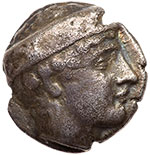 |
Elis, Olympia. 98th Olympiad. Silver Stater (11.66 g), 388 BC. Head of Hera right, wearing stephane adorned with two palmettes and two lilies connected by tendrils. Reverse: FA (retrograde), flaming thunderbolt; all within olive wreath. Seltman 281; BCD Olympia 93. Struck in high relief on a slightly irregular flan. Rare. Toned. Fine / Very Fine. Estimate Value $500 - 600
Purchased from NFA in the 1980s (with ticket).
View details and enlarged photos
| Realized
$705 |
Lot 2111 |
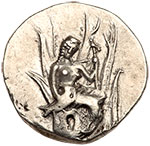 |
Crete, Gortyna. Silver Stater (11.42 g), 4th century BC. Europa seated half right in bough of tree, resting hand on branch below and holding eagle(?)-tipped scepter. Reverse: Cretan bull standing right, head facing; below, bee. Svoronos 70, pl. XIV, 17 (same dies); Le Rider 67, pl. XIX, 3 (same dies). Overtstruck on an earlier coin. Excellent metal. Unusually well struck on a nice large flan, well centered with a light grey tone. Extremely Fine. Estimate Value $5,000 - 6,000
Europa was a Phoenician princess whose beauty attracted the attention of the god Zeus. Desiring her, he turned himself into a magnificent white bull and intermingled with her father's herd. When she saw him, she approached him and stroked his side, then leaped onto his back. Zeus immediately ran out to sea and swam to Crete, where Europa became the island's first queen. Subsequently, Zeus arranged the stars known as the constellation Taurus in the shape of the white bull which he had assumed during this episode.
View details and enlarged photos
| Realized
$6,756 |
Lot 2112 |
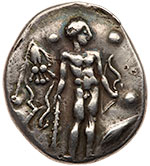 |
Crete, Phaistos. Silver Stater (12.03 g), ca. 330-320 BC. Herakles standing facing, head right, resting hand on grounded club and holding bow; in left field, lion's pelt; in lower right field, laurel leaf corn; around, three pellets. Reverse: Bull walking right within wreath. Svoronos 21; Le Rider 15, pl. XXI, 13 (same dies); SNG Copenhagen -; BMC 6. Rare. Lightly toned. Choice Very Fine. Estimate Value $2,000 - 2,500
View details and enlarged photos
| Realized
$1,175 |
Lot 2113 |
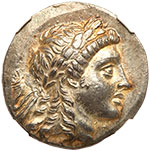 |
Aiolis, Myrina. Silver Tetradrachm (16.86 g), ca. 155-145 BC. Laureate head of Apollo right. Reverse: MYPINAIΩN, Apollo Grynios standing right, holding branch and patera, omphalos and amphora at feet; in inner left field, monogram; all within laurel wreath. Sacks issue 18; SNG Copenhagen 221. NGC grade MS; Strike: 4/5, Surface: 5/5. Estimate Value $1,000 - 1,300
View details and enlarged photos
| Unsold |
Lot 2114 |
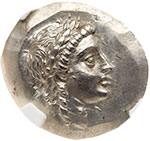 |
Aiolis, Myrina. Silver Tetradrachm (16.27 g), ca. 155-145 BC. Laureate head of Apollo right. Reverse: MYPINAIΩN, Apollo Grynios standing right, holding branch and patera, omphalos and amphora at feet; in inner left field, monogram; all within laurel wreath. Sacks issue 27; SNG Copenhagen -. Boldly struck in very high relief. Lustrous and untoned. NGC grade MS; Strike: 4/5, Surface: 3/5. Estimate Value $1,000 - 1,300
View details and enlarged photos
| Unsold |
Lot 2115 |
 |
Lesbos, Mytilene. Electrum Hekte (2.51 g), ca. 412-378 BC. Head of female right, hair bound in sakkos. Reverse: Kithara in linear square within shallow incuse square. Bodenstedt 79; HGC 6, 1005. Scarce. Well struck and delicately toned. A very choice example. NGC grade AU; Strike: 4/5, Surface: 4/5. Estimate Value $600 - 800
View details and enlarged photos
| Realized
$764 |
Lot 2116 |
 |
Lesbos, Mytilene. Electrum Hekte (2.54 g), ca. 377-326 BC. Veiled head of Demeter right, wearing wreath of grain ears. Reverse: Tripod tied with fillet in linear square within shallow incuse square. Bodenstedt 91; HGC 6, 1017. Rare. Needle sharp and well struck from artistic dies. A superb example! NGC grade Ch AU; Strike: 5/5, Surface: 4/5. Estimate Value $1,000 - 1,300
View details and enlarged photos
| Realized
$1,293 |
Lot 2117 |
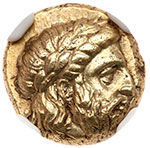 |
Lesbos, Mytilene. Electrum Hekte (2.54 g), ca. 377-326 BC. Laureate head of Zeus right. Reverse: Forepart of serpent right in linear square within shallow incuse square. Bodenstedt 96; HGC 6, 1022. Scarce. A marvelous specimen boldly struck in high relief and lightly toned. NGC grade Ch AU; Strike: 4/5, Surface: 4/5. Estimate Value $700 - 800
View details and enlarged photos
| Realized
$1,058 |
Lot 2118 |
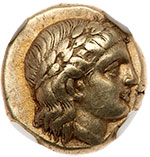 |
Lesbos, Mytilene. Electrum Hekte (2.52 g), ca. 377-326 BC. Laureate head of Apollo right. Reverse: Head of Artemis right; behind, serpent; all in linear square within shallow incuse square. Bodenstedt 100; HGC 6, 1026. Nicely centered in high relief and lightly toned. NGC grade XF; Strike: 5/5, Surface: 4/5. Estimate Value $500 - 600
View details and enlarged photos
| Realized
$588 |
Lot 2119 |
|
Withdrawn
| Unsold |
Lot 2120 |
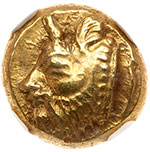 |
Ionia, Phokaia. Electrum Hekte (2.59 g), ca. 521-478 BC. Horned head of river god left; behind, seal. Reverse: Quadripartite incuse square. Bodenstedt 35; SNG von Aulock -. Boldly struck and perfectly centered. NGC grade AU; Strike: 5/5, Surface: 4/5. Estimate Value $800 - 900
View details and enlarged photos
| Realized
$1,175 |
Lot 2121 |
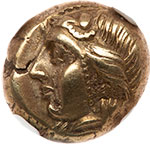 |
Ionia, Phokaia. Electrum Hekte (2.53 g), ca. 478-387 BC. Head of Io left; below, seal left (mostly off flan). Reverse: Quadripartite incuse square. Bodenstedt 96; SNG von Aulock 1710. Well struck and nicely toned. NGC grade AU; Strike: 4/5, Surface: 4/5. Estimate Value $500 - 600
View details and enlarged photos
| Realized
$447 |
Lot 2122 |
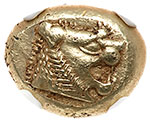 |
Lydian Kingdom. Alyattes to Kroisos. Electrum Trite (4.74 g), ca. 610-546 BC. Sardis. Head of roaring lion right, multiple-rayed sun on snout. Reverse: Two incuse square punches of unequal size. Weidauer grp. XVI, 86-9; SNG Kayhan 1013; Bendenoun, Coins of the Ancient World, A portrait of the JDL Collection, Tradart 2009, 29 (this coin). Well centered and superbly struck. NGC grade Ch AU*; Strike: 5/5, Surface: 5/5. Estimate Value $4,000 - UP
From the Dr. Patrick Tan Collection. Ex NAC 79 (20 October 2014), 15; Peus 368 (25 April 2001), 205; Aufäuser 8 (10 October 1991), 205.
This exemplary specimen of a Lydian lion trite (third stater) belongs to the dawn of coined money in the western world. Prior to the introduction of coinage, exchange had to be made through barter or silver cut up and weighed ('Hacksilber'). Coinage was pioneered in the Lydian kingdom of the Mermnad dynasty, which was uniquely placed to ensure the spread of the new medium of exchange. The kingdom dominated much of Asia Minor, including the many Greek cities of the western coastline, and had access to vast mineral wealth, including the flakes and nuggets of electrum (an alloy of gold and silver) found in the Paktolos River of Lydia proper. It was long believed that the earliest Lydian coinage was struck from naturally occurring electrum, but more recent metallurgical analyses have shown that the gold and silver content was closely controlled from the start.
View details and enlarged photos
| Realized
$14,100 |
Lot 2123 |
 |
Caria, Knidos. Silver Tetradrachm (14.76 g), ca. 395-380 BC. Eudoros, magistrate. K-[NI], head of Aphrodite left, hair bound with ampyx and sphendone, wearing single-pendant earring and pearl necklace; behind neck, prow left. Reverse: Forepart of lion left; above, bee; to left, magistrate's name: EYΔΩPO[Σ]; all within incuse square. Hecatomnus 10d (A4/P10; this coin); SNG Keckman 165 (same dies); SNG Lockett 2366 = BMFA Suppl. 190 = Pozzi 2589 (same dies). Boldly struck in high relief with attractive multi-colored undertones. Very rare. NGC grade Ch AU; Strike: 5/5, Surface: 4/5. Fine style. Estimate Value $6,000 - UP
From the Dr. Patrick Tan Collection. Ex Allan Smith, M.D. Collection (CNG 102, 18 May 2016), 513; Peus 407 (7 November 2012), 629; Aufhäuser 13 (7 October 1997), 189; Hecatomnus Hoard.
View details and enlarged photos
| Realized
$6,756 |
Lot 2124 |
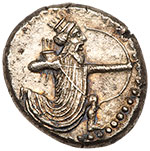 |
Caria, Achaemenid Period. Silver Tetradrachm (14.67 g), ca. 350-334 BC. Ca. 341-334 BC. Persian king or hero in kneeling-running stance right, drawing bow. Reverse: Satrap on horseback right, thrusting spear; in upper left field, head of Herakles right, wearing lion's skin headdress. Konuk grp. 5; SNG Copenhagen 290-1. Unpublished in the standard references with this symbol. Boldly struck on a somewhat porous planchet. Well centered on a full flan. Very Rare. Extremely Fine. Estimate Value $5,000 - UP
This anonymous tetradrachm belongs to an enigmatic Carian coinage struck before the invasion of Alexander the Great and consisting of two series, one lacking additional symbols and the other featuring symbols behind the horseman, like the head of Herakles seen here. The presence of only the unmarked series in the Pixodaros Hoard (closed ca. 341/0 BC) has led to the conclusion that the marked series, to which the present coin belongs, must have been produced after 341 BC. With this date it is tempting to suggest that the marked series may have been struck in the context of the dynastic dispute between Ada, the rightful female satrap of Caria, and her usurping brother, Pixodaros. In 340 BC, Pixodaros forcibly expelled Ada from the capital at Halikarnassos and claimed power for himself. She fled to the Carian fortress of Alinda where she continued to rule in exile. She remained in exile after the death of Pixodaros (ca. 336 BC) and the transfer of power to his Persian brother-in-law, but she was restored by Alexander the Great in 334 BC after offering to adopt him as her son.The types used for this coin are explicitly Persian, advertising the loyalty of the anonymous issuer to the Achaemenid dynasty of Great Kings. The obverse depicts the Great King (sometimes described as a hero) shooting a bow, drawing from the iconography of the already well-known royal/heroic archer obverses used for Persian sigloi struck by the satraps of Lydia since the end of the sixth century BC. The reverse depicts a cavalryman wearing the distinctive Persian kyrbasia headdress. Taken together, the types exemplify the noble ethos attributed to the Persians by the Greek historian Herodotus, who reports (1.136) that until age twenty, Persian youths were only taught three things: to ride, to shoot straight, and to speak the truth. The first two elements of this education are illustrated by the coin types, but the truth of the coin could only be determined with a scale.
View details and enlarged photos
| Unsold |
Lot 2125 |
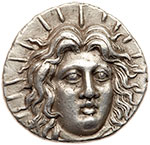 |
Caria, Rhodes. Silver Tetradrachm (12.94 g), ca. 304-190 BC. Tharsytas, magistrate. Radiate head of Apollo Helios facing slightly right. Reverse: P-O, rose with bud to right; above, magistrate's name: ΘAPΣYTAΣ; in left field, eagle standing right with wings spread on thunderbolt. Ashton 215; SNG von Aulock 2802. Well struck on a nice wide spread flan. Lightly toned. Extremely Fine. Estimate Value $5,000 - 6,000
View details and enlarged photos
| Unsold |
Lot 2126 |
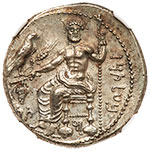 |
Cilicia, Tarsos. Mazaios. Silver Stater (10.82 g), Satrap, 361/0-334 BC. Baaltars seated left, holding eagle, grain ear, bunch of grapes and scepter; below throne, symbol. Reverse: Lion attacking bull left; below, Aramaic letter. Casabonne series 2; SNG BN -; SNG Levante 106. Lustrous surfaces and lightly toned. NGC grade MS; Strike: 5/5, Surface: 4/5. Fine style. Estimate Value $1,000 - 1,400
View details and enlarged photos
| Realized
$1,175 |
|
|